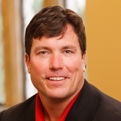Medical plans: An inside look at health careers
STUDENT EXPERIENCE
For students who plan to become a doctor or other medical professional, the path is often clear. Attend a four-year college, take the prerequisite classes, prepare for the MCATs. Then, four years of medical school, followed by a residency and, potentially, a subspecialty fellowship.
It’s a long-term commitment with the added pressure that a single misstep could derail years of planning.
In his Healthcare and Medical Humanities course, Rick Mayes, professor of health policy, hopes to pull back the curtain and give students an inside look at the years ahead — and a view of alternative medical careers, such as becoming a physician’s assistant or physical therapist.
The yearlong class is one of the University’s Sophomore Scholars in Residence programs, which combine a traditional academic course with co-curricular learning activities throughout a student’s sophomore year. In it, students learn how various innovations have increased life expectancy and how disparities in overall health have increased in the U.S. Mayes says his students are typically interested in becoming doctors, nurses, dentists, therapists, and other health professions.
Students get to see someone who’s just one or two steps ahead of them.

The crux of this year’s class was a fall break trip to Boston, including stops at the Harvard School of Public Health and MGH Institute of Health Professions. Students also met with UR graduates — many alumni of the same SSIR program — for tours of their hospitals and medical schools.
“The trip is for them to actually see themselves at a school of public health,” Mayes said. “And it’s so valuable that most of the alumni are in their mid- to late-20s, maybe early-30s. Our students get to see someone who’s just one or two steps ahead of them.”
Evan Wolff, a pre-med student interested in emergency medicine, signed up for the SSIR class to better understand healthcare in the U.S., and to get a deeper look at his future career path. He said the meetings with alumni were particularly valuable.
“Since pre-med is the largest pre-health cohort on campus, many of the discussions are dominated by doctors,” he said. “It was refreshing to talk to alums who were nurses, nurse practitioners, physician assistants, researchers, and in public health.”
By framing the class as an SSIR, Mayes is hoping to catch students at a critical moment in their college development. It’s a chance to form deep friendships built on shared academic interests. Their fall break trip also included an excursion to Acadia National Park in Maine in an effort to foster a tight-knit bond.
Sophomore Ariana Sosa said she appreciates the vulnerability that comes with feeling comfortable with her classmates. She added that it’s comforting to know she’s not alone when facing the challenges of her pre-health track, and that practice having open conversations with peers will be necessary to addressing issues in the American healthcare system.
Mayes added that sophomore year is also when many students declare a major. He hopes that exposure to hospitals and hearing from alumni about the ups and downs of their journey to medical school will help students make an informed decision. Or, perhaps talking to genetic counselors, medical researchers, and more will help them realize that becoming a doctor isn’t the only path forward.
“It’s a chance for these students to take a breath,” he said. “Maybe they’ve been saying they wanted to a be a doctor since they were 5 years old. They get to ask, ‘Do I really want that? Am I up to this? It looks intense.’”

